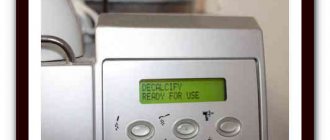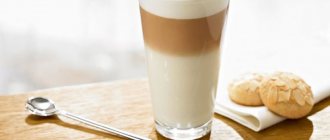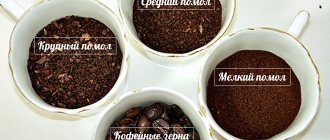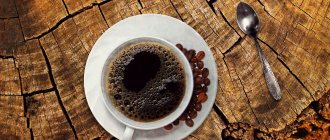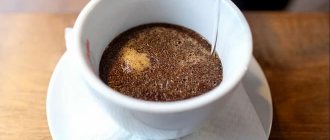Home » Subjects » Russian language » Vocabulary
We use the word “grind” correctly when we are talking about coffee, grain, etc. The word “grind” means “to rub with chalk.”
Both words “melit” and “grind” exist in Russian. They differ in sound and lexical meaning, and therefore in their compatibility with other words. Let’s find out in what speech situation we will say “grind” correctly, and when we will say “grind”.
- What can you “grind”? Examples
Short description
It is necessary to pay attention to the vowels that are located in the suffixes of participles. These words were formed from different verbs, which is why they have different suffixes. The participle with the particle -yash comes from the verb chalk (to rub with chalk). The word with the affix -yushch was formed from an elementary conjugation. In verbal formations the vowels should be written -у, -у, -е. But in words of the second conjugation you will need the letters -a, -ya, -i. Basic example sentences:
- Our mutual friend, grinding a cue, was thinking about something. At this time, he could pray for good luck as his face was focused. Because of this, he could sharpen the cue a lot.
- A peasant who grinds regular flour can enjoy aromatic pastries and delicious pies. These people know how difficult it can be to grind grains that are too small, which may require outside help, as well as good protection against bread moths.
Depending on the meaning of the verb, these 2 options may contain a gross error. The common conjugation grind will look appropriate when talking about coffee or grain. But chalk has a completely different meaning, which is associated with the expression rub with chalk. To present information in writing, absolutely all the nuances must be taken into account.
The expressions melit and grind are used in Russian. They differ from each other not only in sound, but also in lexical meaning and compatibility with other words. It is necessary to determine in advance in what speech situation it would be appropriate to say grind and when to grind.
The word grind denotes a specific action and answers a logical question (what to do?). This verb has an imperfect form, which has several meanings:
- Grind the ingredient to turn it into powder.
- Carefully crush the grain, turning it into flour. The workers tried not to quarrel, since the strong wind prevented them from grinding grain to fill the empty vat.
You can grind coffee, grain, flour, medicinal herbs. In a figurative meaning, the word grind can appear in the phraseological unit grind with tongue (to talk idle talk, to chatter). In some cases, this verb can be replaced with melit, which is absolutely wrong. It is quite possible that this particular speech error arises by analogy with the present tense forms of the verb grind. In their root there is a specific alternation of the vowels -o and -e.
How to grind coffee correctly
Each method of brewing a coffee drink requires a special grinding of the beans. The degree of grinding affects how the beans will release their oils to the liquid, which is why each brewing method requires the barista or coffee lover to carefully select the grind size. It’s easier to achieve perfect grinding using professional equipment, but it’s also possible using homemade tools.
Grinding coffee beans can be divided into the following types:
- Coarse or large, suitable for brewing a drink in a coffee pot or French press, reaching 1 millimeter in diameter. Grinding can achieve such grinding using a blender or food processor.
- Medium, easily obtained by manually grinding beans with a hammer, suitable for drip coffee makers.
- Thin, required for Turkish coffee machines, geyser coffee makers. You can try grinding coffee to this fraction without a coffee grinder using a rolling pin.
- Extra-fine powder essential for brewing perfect Turkish coffee. You can get it by using a mortar.
At home, coffee beans can be ground to any size without a coffee grinder or blender, which means that even beginners can brew a delicious drink of the required strength and taste, just with a little effort.
Key Features
In the Russian language, the expression grinding is used in many sentences; why -yu is used can be figured out if you study all the important rules. The letter -o is written at the root of the original infinitive and related words. For example: ground rolled oats, ground coffee, ground flax. Only depending on the meaning of the sentence can you choose the most suitable option, which will not go out of the general context. For example:
- Victoria began grinding natural coffee to eventually brew a tasty and aromatic drink. Every morning she goes to the nearest park to breathe fresh air, where she can discuss important news.
- Early in the morning, our grandfather took the collected grain to the mill. He loves to watch it being ground in special machines with multiple functions.
- He didn’t seem to hear us and stubbornly continued to talk nonsense. Maxim spoke real nonsense, which means that we will never get the long-awaited translation of the text about the subsoil (part of the earth’s crust).
- Only with an electric meat grinder can you grind meat as efficiently and quickly as possible to prepare good minced meat.
The student needs to learn to conjugate and distinguish the verb from a similar example, melit. But in practice, this verb is related in meaning to the word chalk. This nuance cannot be ignored. A billiards player has to regularly chalk his cue so that during the next shot it does not accidentally slip off the ball. But the tailor grinds the buttons in order to sew them onto the clothes as correctly as possible.
Books on the Russian language contain many examples that were formed from the verb to grind. The participle is necessarily subject to morphological analysis, which can have several options, which is why the student needs to be able to independently choose the most appropriate analysis option based on the context of the sentence. The verb used to grind is of the first conjugation, which is why it has the corresponding endings.
But the verb melit ends in -it, which is why its conjugation occurs according to the second type. Each case is individual, since everything depends on the meaning of the sentence. A thorough study of all the rules and examples will help you better understand the intricacies of writing words that seem difficult at first glance. This approach is practiced in linguistics, where every nuance plays a huge role.
Ways to make ground coffee at home
Neapolitan coffee is prepared very simply in a geyser coffee maker. Water is poured into the lower reservoir of the device, covered with a filter and screwed on with a lid. Finely ground coffee is poured into the upper part. When boiling, the water fills the coffee reservoir, turning into a delicious, invigorating drink.
If you need to brew a drink from coarsely ground beans, a French press is suitable, which is preheated by pouring boiling water in and out of it. Then put 3-4 teaspoons of coffee into a glass, pour a small amount of boiling water over them and stir. After 30 seconds, the French press glass is completely filled with boiling water and left for 5-6 minutes.
Morphological analysis
Quite often in test work on the Russian language there is a need to perform a qualitative analysis of a specific example. Morphological analysis is a detailed description of a word form. In this case, changeable and constant features must be determined, as well as the semantic role in a phrase or sentence.
Word parsing must be performed in the following sequence:
- The part of speech to which the expression refers is recorded.
- The initial form and morphological characteristics are determined.
- Constant characteristics are established (inanimate or animate, common noun or proper, declension, gender).
- The case and number are recorded.
- At the final stage, all that remains is to determine the syntactic role of the word.
This review plan was compiled by experts based on generally accepted rules, since everything depends on the class and teacher preferences.
Performing a morphological analysis of the word grinding is quite easy and quick:
- The part of speech is the participle, which was formed from the verb to grind.
- Main morphological features: initial form - grinding (masculine nominative singular); inconsistent features - nominative case, singular, full form, masculine; constant signs - present tense, imperfect form.
- Syntactic role - can be performed by absolutely any member of the sentence, since you need to look at the context.
On the Internet you can find special programs that perform morphological analysis of words automatically. Elementary writing of words with spelling patterns protects the student from making gross mistakes. Before analyzing the example being studied by composition, you need to determine its part of speech. Otherwise, the student may become confused in the analysis being performed, as a result of which the final grade for the completed work will be significantly reduced. It is forbidden to use the words dare and molet.
How to improve your speech: 5 useful tips
This article will teach you how to improve your speech. If you follow these simple guidelines, you will learn how to make your speech beautiful.
When talking about public speaking, there are simply no small details - every detail is important.
When you master rhetoric, try to remember that your speech should also be clear and you should also improve your diction.
If you swallow most of your words during a conversation or people around you cannot understand what you are saying, you should try to improve the clarity of your speech.
In the article below you will find several methods by which you will learn how to improve your speech .
You'll be able to speak more clearly, whether you just need to communicate, your profession requires public speaking, or you just want to improve your speaking.
How to Improve Your Speech: Take Your Time When Conversing
- Control your breathing.
Listen and watch a singer on stage and you will see how much attention he pays to his breathing.
The same thing happens when speaking, so proper breathing can greatly improve the clarity of your speech.
- One way to ensure proper breathing is to place one hand on your stomach and the other on your chest while you breathe.
You need to breathe so that the hand on your stomach moves, and the hand on your chest remains motionless.
Breathing with your stomach (diaphragm) will definitely provide you with a full, real breath and allow you to speak in a rich voice.
- Speak when you are breathing fully.
Once you have taken the right breath, you should start speaking and thinking about the words.
Also, remember to exhale slowly and gradually during this time.
This will allow your breathing to support your speech and will likely allow you to act naturally and not rush.
- Take your time when communicating.
Your speech should be unhurried, but not too slow so as to avoid appearing robotic to other people.
Clarity of speech is determined not only by the correct wording of the phrase, but also by the clearest expression of your message or point of view.
This often means understanding what you are going to say so that you don't have to deny what you said.
How to read faster?
- Public speaking is another way to improve your public speaking skills.
If you have to give a speech or give any kind of presentation, you're probably better off writing the content, at least in general.
Practice saying this while walking.
Some actors use this method to learn their lines because getting up and moving can help you remember what you're going to say.
Practice your speech and say one word at each step.
It may seem slow and difficult at first, but by saying one word at a time, you will definitely learn to slow down your speech.
You don't need to speak this slowly in your speech or during normal conversation, but the comfort of using a slower speaking rate will improve the clarity of your speech and allow you to take your time in the future.
- Repeat the words that are difficult for you to say.
When we encounter difficulty in pronouncing certain words, we often start to rush and stumble over those words, which in turn leads to confused speech.
Practice saying these words by saying them out loud over and over until you develop a muscle memory of how to pronounce them correctly.
For example, the words "Squirrel", "Brewery", "Phenomenon" and "February" are considered some of the hardest words to pronounce because their spelling is so different from how they sound.
To help you pronounce difficult words, try pronouncing them phonetically.
How to improve speech: diction exercises
- Tap the entire mouth with your tongue.
Make several rotational movements with your tongue.
Run it over your teeth as if you were brushing them and try to reach the roof of your mouth with your tongue.
- Tap your fingers on your lips, cheeks, nose and chin.
Puff out your cheeks as if your skin were a tight drum.
Tap all these places with your fingertips, like sticks.
- Practice tongue twisters daily to improve speech and articulation for at least 5 to 10 minutes.
Start at a slow pace and gradually increase the speed until you are saying them at your normal speaking rate.
When you say them, overemphasize the words, forcing your tongue, jaw, and lips to work.
Once you know how to say them, start speaking in the actor's rich voice and emphasize the words even more.
This can improve your skills and develop those muscles of the mouth that are responsible for speech function.
Signs of High Intelligence
- Tongue twisters can be complicated.
For example, before pronouncing tongue twisters, you can put several small pebbles or nuts in your mouth.
Surely, in this case, you will have to make a lot of effort to pronounce this phrase clearly and clearly.
This way you train your mouth muscles and improve your speech.
- Another popular exercise in speech practice is speaking with your mouth closed.
Simply because your lips are closed, it will be more difficult for you to make sounds.
That's why you should use the extra skill and willpower to say at least a few clear words.
Your diction and articulation in ordinary speech will improve significantly after this training.
- Exercise your jaw muscles to improve your speech clarity.
To make your speech clearer, relax your jaw with a couple of exercises.
Make wide excursive movements and at the same time sing something to yourself.
Stretch every muscle in your jaw and face.
Open your mouth as wide as possible (as if you are about to yawn) and at the same time draw a circle with your lower jaw and move it from side to side.
Open your mouth wide, as in the previous exercise, and close it.
Repeat these movements 5 times.
Using closed lips, try to make a buzzing sound, but do not close your jaws.
What books should I read to become smarter?
- Warm up your vocal cords.
Warming them up will leave you relaxed and ready to speak clearly and effectively.
Even if you don't usually sing, you can sing a few notes or just whisper to yourself.
You can also sing tongue twisters.
Say “Uuuuu...” several times, changing the intonation from high to low and vice versa.
Imagine that your voice is like a Ferris wheel that moves up and down, forming a circle.
Makes a buzzing sound and claps its hands.
This will help you get rid of phlegm that may accumulate in your throat.
5 Useful Tips for Improving Speech
- First, you should read more to improve your speech and vocabulary.
Newspapers, magazines, high quality fiction.
Read and reread the classics!
And do it out loud, slowly.
Such a reading is sure to have a colossal effect.
It will teach you how to form words and sentences and expand your vocabulary.
- Secondly, try, if possible, to remain calm, do not wave your arms or reflect strong emotions in your speech.
This will only increase your level of trust and add authority.
Your speech should consist of simple phrases and should not be in a hurry.
- Third, watch the pace of your speech.
It shouldn't be monotonous.
You can separate key points in a conversation with a pause.
It should be suitable and not too long.
- Fourth, use various comparisons, metaphors, figurative expressions, sayings, etc. in everyday speech and conversation.
This will definitely make your speech more lively and interesting.Of course, the safest option is humor.
Appropriate self-irony and jokes can add polish to your speech.
Words are only a means of conveying information, and the way you combine those words and pronounce them is either memorable or not.
- Finally, speak and practice your speech as often as possible.
This is quite easy to do if you have a lot of friends.
Otherwise, television or radio may help.
Choose the TV presenter you like best and try to imitate him.
Repeat out loud (!) everything he says and try to reproduce the same intonations of speech.
This is not easy to do, but later you will definitely see how much you have improved your speech.
In addition, you will not only improve the melody of your speech, but also expand your vocabulary.
So, use these tips on how to improve your speech , and try to speak clearly, clearly and understandably.
Then people will see you as a driven person and will treat you with respect.
In addition, thanks to the ability to speak correctly, you will always be a good and pleasant interlocutor.
Useful article? Don't miss out on new items! Enter your email and receive new articles by email
.
Phonetic approach
Analyzing a word using this technology increasingly causes certain difficulties, although this is the task that students in grades 5–9 often perform. The essence of phonetic analysis is not only to hear, but also to transfer the sound of a word onto paper. At the initial stage, students can make numerous mistakes due to the fact that the letter does not always correspond to the pronunciation.
The key feature of phonetic analysis is maximum concentration on correct pronunciation. A spoken unit of speech that is not only heard, but also pronounced - sounds. An elementary symbolic image of audible material - letters.
The traditional spelling and subsequent pronunciation of the same word most often do not coincide. There can be much more or less letters than sounds. This discrepancy can well be explained by the current rules that affect the orthoepic and orthographic categories. But phonetics reserves the rules of pronunciation.
The correct phonetic analysis of the word grinding can be completed in just a few minutes. The example includes 3 syllables: grinding. The transcription is as follows - [m'el'ush'iy']. The word contains 7 letters and 7 sounds. Analysis of the word grinding in accordance with phonetic norms looks like this:
- M - [m'] - consonant, sonorant. soft, par.
- E - [e] - vowel, stressed.
- L - [l'] - consonant, sonorant. soft parn.,
- Yu - [u'] - vowel, unvoiced.
- Ш - [ш'] - agrees, deaf, unpaired. soft unpaired
- And - [and'] - vowel, unstressed.
- J - [th'] - consonant, sonorant, soft, unpaired.
For complete figurative perception, as well as a guaranteed understanding of the structure of a speech unit, specialists created a sound model of the word. It is best to resort to developing a scheme in the form of original multi-colored rectangular and square cards. The sound model consists of cards laid out in a clear sequence. This approach is actively used in kindergartens and primary classes. In addition, the scheme for parsing words into sounds and letters helps to radically improve the pronunciation of consonants and vowels.
Word analysis helps a person develop his phonetic ear, strengthen and improve his memory, and also better understand some important spelling rules. Knowledge of a basic parsing algorithm allows you to complete the task quickly and efficiently.
What else can a coffee grinder grind?
Last updated May 10, 2022 Posted by Know Your Grinder
You might not be entirely surprised to learn that there are many other things you can grind with a coffee grinder besides coffee.
There are a few things that come up over and over again that people ask about all the time.
So, we've put together a list of frequently asked questions (FAQs) about "can a coffee grinder grind...", as well as some specific recommendations for certain types of grinders that may be useful for each substance you want to grind.
Table With content
- Can a coffee grinder grind?
Let's get down to business!
Let's start by explaining whether a coffee grinder can grind spices.
Can a coffee grinder grind spices?
One of the most frequently asked questions is: can a coffee grinder be used as a spice grinder?
Typically, the answer to this question... depends on the circumstances. As disappointing as this answer may be, it is true.
Okay, then what does it depend on? Since "spices" is such a broad term and some spices are harder to grind than others, it depends on both the grinder and the spice you're grinding.
Most of the time people wonder if the spice is too hard to grind, but it's also worth considering if the spice is soft, which can have its own problems - like making more of a mess and smelling the machine if you don't apply it and not clean it properly .
Yes, and if there is moisture in the spice, don’t even think about it! Moisture will cause the grinder to rust (see the next section on food processors for more details).
We think the best option is to buy a coffee grinder that advertises itself as a spice grinder, and there are many of them. In fact, many coffee grinders advertise and design their grinders specifically for grinding spices as well as coffee.
Burr Grinding Vs. Blade "Grinding"
Most often, spice grinders are grinders with blades specifically designed to “grind” spices.
When it comes to grinders, technically speaking, they actually cut your spices into slices rather than "grind" them, which is more like mashing.
This also applies to coffee. However, some will say that they are the same thing. When it comes to coffee, it's really not the same—blades sometimes have a negative impact on the flavor, especially with espresso—but with spices, blade grinders are really your best, cheapest, and fastest option.
Here's a short video of the Cuisinart SG-10 Spice and Coffee Grinder, which does a great job of grinding most spices.
The best-selling KRUPS F203 is available for under $20 (depending on where you buy), and it's actually advertised as a spice grinder, not the other way around. The reasons to buy a spice grinder like this are simple.
If you want to experiment with grinding different spices, the KRUPS F203 Spice Grinder is cheap enough that if your experiment fails, you'll only be looking at $20 instead of $100 or more.
If you're a chef, chances are you're still going to use one of those $20 grinders to grind your spices because they're damn effective and we haven't seen any super expensive spice grinders out there. that do the job better.
Seasonings that KRUPS F203 customers have successfully ground include: flax seeds, cinnamon, nuts, rice, oats, and anything that might be less hard or harder than coffee beans (and coffee beans themselves are quite hard). It can also be used to grind herbs.
Because the KRUPS F203's blade sits very low in the body, it makes it a more efficient shredder for almost anything you throw at it.
Of course, there are several coffee/spice grinders on the market, so the KRUPS F203 is not alone in this ability, although it is very popular with thousands of customer reviews singing its praises.
Another coffee grinder model that is great for grinding spices is the KitchenAid BCG211OB (pictured below).
Some other important general questions you'll want to ask regarding spice grinding include:
- What exactly are you grinding here that is likely to smell bad or be difficult to clean?
- How easy is it to clean a coffee grinder?
- Material: stainless steel or plastic?
- Are you going to use it later for coffee or other flavors?
Grinding spices with coffee mill
As for coffee grinders, these too can be used to grind select spices. Obviously, there are size limitations, as is the case with electric grinders with blades, and you have to remember that this time you will be grinding with burrs instead of blades.
Grinding with burrs changes the game a bit. Take a coffee grinder like Hario Skerton, one of the most popular burr brands available today. You have to remember that since it is a coffee grinder, it is not the same as a spice grinder. Burrs are specifically designed for grinding coffee, although the point is that yes, they work with some spices.
Here is a list of spices that grind well with the Skerton and probably other grinders, although we recommend being careful not to break it:
- Allspice berries
- Cinnamon (although this is not easy and may break the grinder)
- Cardamom seeds
- Cumin seeds
- Oregano
- Coarse crystalline salt
- Wheat Berries (again, another tricky, risky one, but done)
- Rice (difficult, risky, but doable)
In general, coffee grinders are not designed specifically for spices, but for this reason you can definitely benefit from them. There is another option for spices that we haven't explored...
Grinding spices using a mortar and pestle
If using an electric spice grinder or burr grinder doesn't sound like the right method for you, there's really only one practical option that people use to grind spices and that's a good old fashioned mortar and pestle.
As old-fashioned as it may seem, there are several advantages to this method.
Benefits of Mortar and Pestle
First, it's less messy. Electric sanders create a bit of a mess with their fast, motor-driven cutting blades.
Even if all the action is contained under the lid, you will need to clean it well between grinding sessions, otherwise you will still retain the flavor of the last spice you crushed.
With a mortar and pestle, since there are no moving parts, it is much easier to clean.
As it turns out, they are very similar in price to many electric spice grinders, mainly due to the materials used, such as marble or granite.
Another benefit is that you can use “wetter” spices in a mortar and pestle. Since it is not mechanical and you can clean it in a few seconds, there are no problems with moisture as with an electronic sander.
The last thing we'll say about the mortar and pestle method is that it is probably the "best" method for grinding spices overall.
Why is “better” in quotes like that? Well, for the same reason that grinding coffee is better with a hand grinder or burr grinder - it is less shocking to the substance being ground and, in many cases, it results in a better taste. Quotes are made because people can always argue about this.
Of course, these were the original grinders, so it stands to reason that if they are still in use today, there is a good reason.
For the same reason, doing things manually is usually better. Faster? Not better. In general, yes. You just need to think about it.
Finally, here's a video from Jamie Oliver demonstrating proper mortar and pestle technique and giving tips on how to achieve maximum flavour.
Next, we will discuss whether a coffee grinder can be used for cooking.
Can a coffee grinder be used as a food processor?
An even broader term than "spices", "food" is so broad that it can mean almost anything.
Chances are, if you're reading this, you most likely have a coffee grinder and just want to see if you can use it the same way you would a food processor. That means chopping everything from nuts to celery to cheese. Wet, dry, whatever...
Short answer: no.
Oh... you won't answer no, will you? Well, then the longer and more complex answer is: well, sort of.
Again, it really depends on what kind of “food” you want to “process.” You need to at least ask yourself the one most important question before you stick that slice of watermelon in the grinder, and that is: Can you go out and wash the grinding chamber separately?
Some cheaper blade sanders may not have removable chambers that can be submerged in water.
If you're really set on using your blade grinder as a mini food processor, you really want to be able to wash it—and the blade—afterward. Otherwise, you may rust any metal parts or, just as importantly, damage the electronic components inside the device.
It's the same with a router - you're probably going to swallow burrs if you're using soft or wet food, and that's not what they're designed for. Dry stuff will do, but wet stuff won't run out. Coffee beans themselves aren't 100% dry, but they're by no means "wet," which is why coffee grinders work well with them.
If you're dead set on purchasing a real quality food processor like, say, the Hamilton Beach 70740 8-Cup Food Processor, which we might add isn't much more expensive (maybe $10 more) than a good coffee grinder, mortar and pestle or blade grinder - then we'll do our best to direct you to a grinder that can grind a wide variety of foods.
True, you could save a few bucks this way, but if you read about them, there are legitimate benefits to using a real food processor.
What do we recommend?
Available for around $30 (*cough* the same price as a food processor), the Secura Electronic Coffee & Spice Grinder is a good choice if you're short on cash and looking for one small item for a bunch of tasks.
It has two detachable grinding chambers with two sets of blades, ideal for chopping and chopping. It is designed with spice grinding in mind, but can handle coffee, nuts and more.
Plus, Secura is very easy to clean, so if you do use it for anything other than coffee, be sure to clean it properly and often. It also comes with a removable bowl for added convenience.
Next, let's talk about using a coffee grinder to grind nuts.
Can I use a coffee grinder to grind nuts?
If you've made it this far, you should already know the answer, since nuts are similar to coffee beans in many ways - the size and even their hardness and texture.
If you're just happily scrolling and want to hear the answer to this particular question, the short answer is yes, but nuts (depending on the nut) may take a toll on your grinder. So, if you're going to be doing this regularly, you might want to get something that's up to the task.
What do we recommend?
For under $20, the reliable Quiseen One-Touch Electric Coffee Grinder may be your best bet here, as it's one of the few grinders that advertises itself as designed specifically for nuts, grains, and spices.
This model is at the reasonable end of the price range for a decent but simple blade sander that does what it says on the tin.
There's a safety lock, a convenient lip, and a clear lid so you can see what you're doing. The weight capacity is 2.5 ounces, so it's not bulky.
Honestly, if you wanted something more, you'd probably look at a food processor.
What about wheat berries? Can they be ground in a coffee grinder? Keep reading to find out...
Can coffee grinders grind wheat berries?
If you want to grind your wheat using a coffee grinder, yes, it is possible, but again, it depends on what kind of grinder you are using. Of course, a larger grinder will do the job, as you can see in the video below:
As you can see, it seems to work great with this type of grinder, but it is one of the more expensive grinders on the market, with a lot of power and heavy burrs. The chances of someone having an expensive coffee grinder that you want to use to grind wheat are very unlikely.
So what about a grinder with smaller blades...will it work? As it turns out, not very well. As you can see in the following video, this woman used a cheaper blade grinder to try to grind her wheat berries, and it didn't work out so well.
Wheat does need grinding, as it always has, which means you'll have to sacrifice your more expensive burr coffee grinder to even try grinding or milling wheat with it at home.
If you have a smaller blade-powered angle grinder, it probably won't work—at least not very well.
Chances are, if you want to grind your own wheat, you'll still want to get a larger amount than you would get from one of those smaller grinders, even if it worked reasonably well.
The good news is that food mills exist and are readily available for home kitchen use. The bad news is that they can be a little pricey, so you might want to make sure you're definitely getting your money's worth from it.
Some enterprising people have come up with ways to make it work with their coffee grinder or even their blender, like this guy right here...
If you still want to try grinding wheat in a coffee grinder, then you risk completely ruining the grinder, especially since if you put wheat through it, it's gluten, so all those poor gluten intolerant people now can't drink coffee any longer.
In addition to this, some unrefined wheat grains contain debris that can also ruin a good coffee grinder.
If you don't want to heed these warnings, just make sure your coffee grinder is set to a fine grind setting. As we said, more expensive grinders will get the job done, but with cheaper blade models, you may just be spinning the wheels for a while and eventually burn out the motor. Not worth it!
Next, we will discuss whether it is possible to grind rice in a coffee grinder.
Can coffee grinders grind rice?
The word "there" in the rice lands is: While it can be done with a mill, it's painfully slow, so it might be worth investing in something more specialized if this is going to be a common occurrence and get a decent amount.
However, the KRUPS F203 grinds rice very well to a state that is quite close to flour. Here is a short video demonstration of using the KRUPS F203 to grind rice flour.
What do we recommend?
At under $100 (depending on where you buy) and with a 32-ounce capacity, this is true kitchen appliance territory.
However, you might be better off with something like this as you can get a decent amount of flour out in less time.
The Vitamix is ideal for grinding all grains, including rice, wheat and other seeds.
On the other hand, you can always just opt for the KRUPS F203, which we mentioned earlier in this article. It's under $20 and seems to do a great job of chopping rice, although it does seem to take a while to chop any significant quantity.
Next, we'll talk about using your coffee grinder to grind flax seeds and chia seeds.
Can coffee grinders grind flax seeds and chia seeds?
Can a coffee grinder grind flax seeds or can a coffee grinder grind chia seeds are two other frequently asked and very popular questions. Both types of seeds have many health benefits, and both have many uses. They are also ideal candidates for grinding, so it's only natural to think of a coffee grinder as one of the possible grinding options.
Chia seeds
High in omega-3s, it can be a way to boost your calcium and niacin intake and be a good supplement since it's easy to add and tasteless.
Flax seeds
Flax seeds, also a source of omega-3, contain vitamins and fiber and can also help with weight loss and as a supplement to combat menopausal symptoms.
If you have already decided to invest in a Vitamix, this would be ideal. If you're still looking at a coffee grinder, there are several that are perfect for the task.
What do we recommend?
As shown in the video above, the Hamilton Beach Custom Grind is ideal for grinding both chia and flax seeds.
It's a bestseller and the original multitasking tool. Complete with a removable grinding chamber for easy cleaning, it can also process nuts, spices, and some of the other substances and grains we've already mentioned in this article.
Priced at under $20, it won't break the bank and is worth a shot for many of your needs.
Ahhhhhhhhhhhhhhhhhhhhhhhhhhhhhhhhhhhhhhhhhhhhhhhhhhhhhhhhhhh happen out of the coffee grinder.
Can coffee grinders grind weeds?
Ah, the age-old question. In fact, this full article on the best weed grinders we wrote on this topic a while ago has quite a bit of information about the performance of grinders and the magic medicinal stuff, so you should definitely check it out if you* want to know.
But briefly about this. A lot here depends on how well you intend to clean said grinder and whether you intend to use it for coffee as well?
Can coffee grinders grind weeds? Hell yes! But do you really want marijuana tasting in your coffee (hey, the answer to that question may very well be different, hell yeah!), but if marijuana flavored coffee isn't your bag, it might be best to keep these two things separately using a removable chamber or you can try a dedicated coffee grinder here.
What do we recommend?
Compact and under $20, the Secura Electric Coffee Grinder is back again as a great choice for a coffee grinder/coffee grinder since you must have come here to grind your herbs with a coffee grinder.
If you don't mind a weed grinder, there is a better option in the form of a four-piece zipper herb and tobacco grinder with a pollen catcher.
It's not a grinder at all, but if you want something that will prevent cross-contamination of your espresso, this might be a better choice.
Not only for recreation, but also for preparing other spices and herbs, even those that are approved for use!
Thank you for reading!
.
Morphemic analysis
In the process of parsing a word, a kind of analysis of morphemes and its components is carried out. At the final stage, the student can much better understand the structure of the example and related words, as well as analyze as much as possible and learn to independently use in practice the mechanisms of word formation in the Russian language. Morpheme is the minimum indivisible significant part of a word that is needed to form new forms.
Some textbooks describe in detail information about morphemic parsing and word analysis as identical parameters. But in practice everything is a little different. During these two analyses, a number of significant differences can be noted. For morphemic analysis, the word is used without any changes, but for analysis by composition, the initial form is required. During word-formation analysis, it is necessary to indicate whether the expression involved is derivative or not.
The morphemic analysis of the word grinding is distinguished by its simplicity: root (mel) + suffix (yush) + ending (ii). The basis is grinding. Method of word formation: suffixal. There is a certain order of morphemic analysis, which is better not to change even if you want to perform a more simplified analysis. It is necessary to follow the instructions, as in this case you will be able to avoid mistakes.
You need to understand that a word cannot have more than one prefix and suffix. To be able to distinguish between these concepts, you need to try to find the closest predecessor of this word in the word-formation chain. To find the ending you need to change the example. The student may encounter a situation where this parameter is null. Suffixes are located after the root and they serve to form new expressions. Finding this component of morphemic analysis is quite simple. A suffix is the part of a word that is located between the root and the ending.
Universal and multifaceted morphemics deals with the analysis of words in parts. In various dictations, exams and presentations you can often find a task that concerns the analysis of the word being studied. If the example is changeable, the inflection or ending is set. Otherwise, it will not be possible to perform a qualitative analysis.
Recommendations for storing ground coffee
If it is not possible to grind the beans immediately before preparing the drink, ground coffee must be stored properly. To preserve the properties of ground coffee, taste and aroma you need:
- store it tightly packaged in a cool, dark place;
- Do not expose it to heat, moisture, sunlight, or bright light.
When stored this way, ground beans retain their properties completely for a week. If storage conditions are not met, the raw material becomes unusable within a day after grinding.
The drink, beloved by millions of people, has many varieties, types, and methods of preparation. Freshly ground coffee is the most delicious. And if you don’t have a coffee grinder or blender nearby, you can grind the beans using any available kitchen tools to brew an aromatic and tasty drink that retains the original aroma and the required strength.
Author: Anton Energetic, especially for the site pokofemanim.ru
Irina
Hello, I'm Irina. I have been a coffee expert for over 15 years. Over the past 6 years, I have tried every coffee there is to try and even opened my own coffee shop. Join me on this journey to learn more about coffee at Pokofemanim.ru

